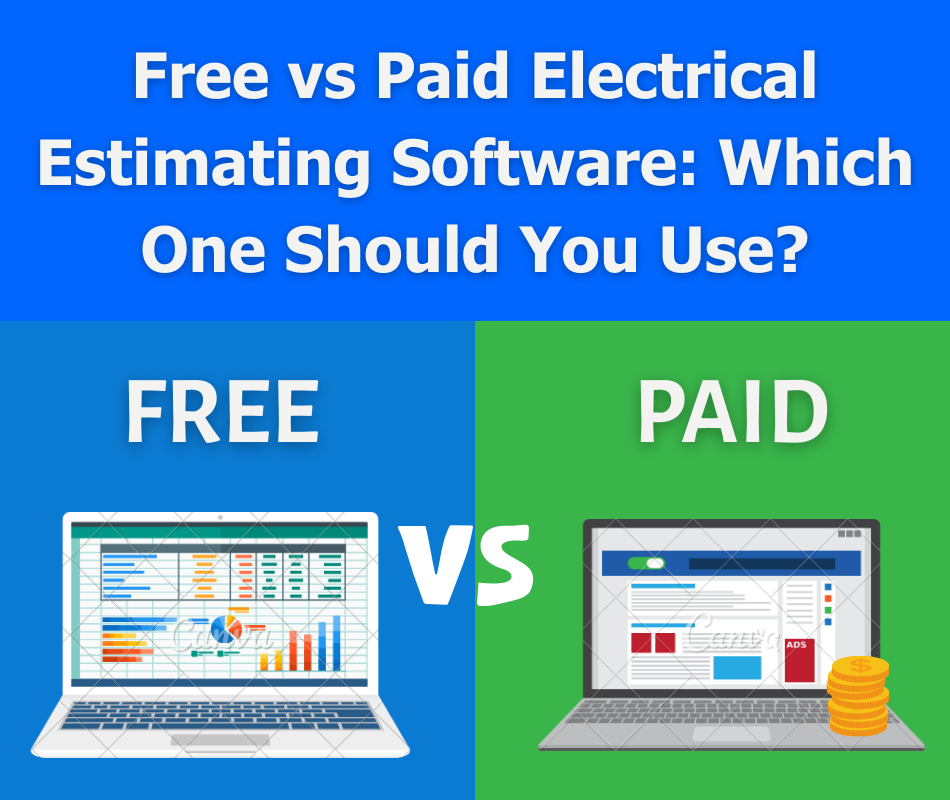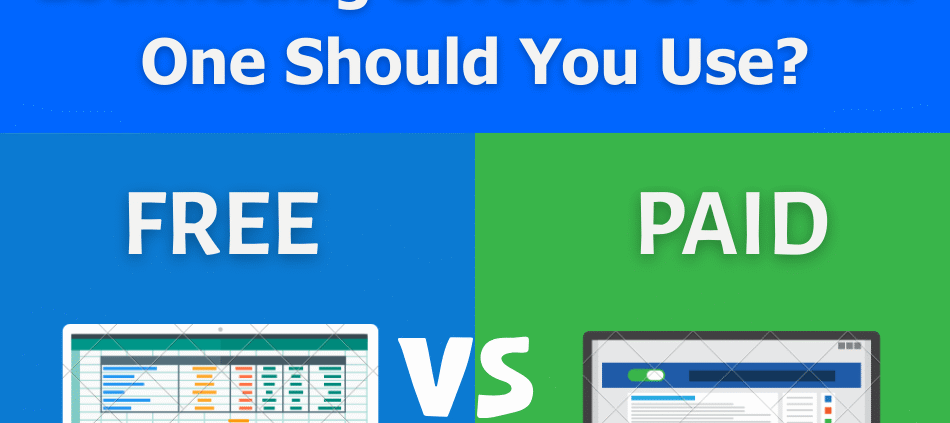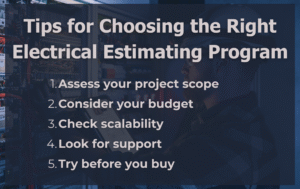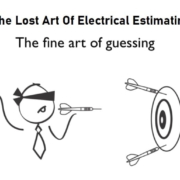
In today’s competitive construction industry, accurate and efficient cost estimating is the backbone of every successful electrical project. Whether you’re a small contractor bidding on residential jobs or a large firm managing multi-million-dollar projects, the right electrical estimating program can make all the difference. With the rise of technology, contractors now have two main options: free electrical estimating software and paid versions. But which one is better suited for your business needs?
This article explores the pros and cons of both free and paid estimating tools for electricians, so you can make an informed decision before investing time and money.
Why Electrical Estimating Software Matters
Traditionally, electricians relied on spreadsheets or even pen-and-paper methods to calculate labor, materials, and overhead costs. While this worked for small projects, today’s fast-paced construction environment demands more accuracy and efficiency.
Modern electrical estimating software streamlines the process by:
- Automating takeoffs from digital drawings
- Updating material pricing in real-time
- Reducing human error in calculations
- Generating detailed proposals for clients
- Saving time on repetitive tasks
Without these tools, contractors risk underbidding (and losing profits) or overbidding (and losing projects). Clearly, the right estimating software isn’t just convenient—it’s essential for staying competitive.
Free Electrical Estimating Software: What You Get
Free tools can be a good starting point, especially for electricians new to digital estimating. Most free programs focus on simplifying basic tasks and helping contractors get comfortable with the transition from manual methods.
Advantages of Free Software
- No upfront investment – Ideal for startups or individual contractors with limited budgets.
- Easy learning curve – Basic features are often intuitive, making it easier to get started.
- Good for small projects – Suitable for simple residential jobs where complex reporting and advanced integrations aren’t required.
- Trial before upgrade – Many free versions are designed to give you a taste of what paid solutions can offer.
Limitations of Free Software
While free options are appealing, they often come with significant drawbacks:
- Limited features: Many free platforms don’t include advanced tools like on-screen takeoffs, real-time material pricing, or labor tracking.
- Restricted scalability: As your business grows, free tools quickly become inadequate.
- Lack of support: Free programs often offer minimal or no customer support.
- Hidden costs: Some “free” software locks essential features behind paid add-ons.
If your business handles frequent bids, complex projects, or requires accurate labor/material cost tracking, free tools may eventually slow you down rather than help.
Paid Electrical Estimating Software: What You Gain
Paid solutions are designed to support professional contractors who rely heavily on accurate and efficient estimating to win projects and maximize profit. Software like Best Bid Hybrid Pro and Best Bid Next Generation are good examples of industry-trusted paid programs.
Advantages of Paid Software
- Comprehensive features – Paid solutions usually include on-screen takeoffs, cost databases, labor reports, proposal generation, and integration with pricing services.
- Accuracy – Advanced automation reduces errors and provides more consistent estimates.
- Scalability – Paid tools can handle large commercial and industrial projects with ease.
- Support and training – Paid programs often include lifetime support, video tutorials, and access to training.
- Ownership benefits – Some providers, like Best Bid, offer one-time payments with lifetime updates, saving contractors from recurring subscription fees.
Possible Drawbacks
- Initial cost – Professional software often requires a significant upfront investment.
- Learning curve – With more features comes more complexity, so initial training is required.
- Overkill for small jobs – If you only handle small, occasional residential projects, you may not use the full potential of paid tools.
Comparing Free vs Paid: Which Is Right for You?
Choosing between free and paid software depends on your business size, budget, and project complexity.
Feature Comparison
| Feature | Free Software | Paid Software | |
| Cost | Free or trial-based | One-time or subscription | |
| Takeoff Capabilities | Basic (if available) | Advanced, built-in On-Screen Takeoff | |
| Pricing Database | Limited or none | Real-time updates & customization | |
| Support & Training | Minimal | Lifetime support, tutorials, training | |
| Scalability | Small residential jobs | Small to multi-million-dollar projects | |
| Proposal Generation | Limited | Fully customizable proposals | |
| Updates | Rare or non-existent | Regular lifetime updates | |
When Free Software Makes Sense
Free estimating tools for electricians are best for:
- Solo contractors or startups testing digital estimating
- Small residential projects with straightforward calculations
- Businesses evaluating different software before committing
When Paid Software Is the Smarter Choice
Paid electrical estimating software is better suited for:
- Contractors bidding frequently on large projects
- Companies needing fast, accurate estimates to stay competitive
- Teams that require collaborative features, takeoffs, and proposal automation
- Contractors who want long-term support, updates, and scalability
Investing in a paid electrical estimating program like Best Bid can save hundreds of hours annually and help you win more bids with confidence.
Case in Point: Best Bid Electrical Estimating Software
At Best Bid, we’ve seen firsthand how the right estimating software transforms businesses. Our Best Bid Hybrid Pro and Next Generation solutions combine speed, accuracy, and affordability. Unlike competitors that charge recurring fees, Best Bid offers:
- One-time payment – Buy once, own forever
- Lifetime updates – Stay current without extra charges
- Free technical support – Always have experts available
- On-screen takeoff built-in – No need for third-party tools
- Unlimited license – Scale your business without paying per seat
For contractors tired of outdated spreadsheets or limited free tools, Best Bid offers a cost-effective, professional solution designed by electricians for electricians.
Tips for Choosing the Right Electrical Estimating Program
- Assess your project scope – Do you mainly handle small residential jobs or large commercial projects?
- Consider your budget – Free tools save money upfront, but paid solutions may provide better ROI.
- Check scalability – Choose software that can grow with your business.
- Look for support – Ongoing training and customer service can make a huge difference.
- Try before you buy – Start with a free trial of paid software like Best Bid to experience the difference.
Final Thoughts: Free vs Paid—Which Should You Use?
Free electrical estimating software has its place—it’s a good starting point for small contractors dipping their toes into digital estimating. However, its limitations become obvious as projects get larger and competition grows tougher.
Paid solutions, on the other hand, offer unmatched accuracy, speed, and long-term value. With features like real-time pricing, built-in takeoffs, and lifetime support, paid software such as Best Bid gives contractors a competitive edge.
At the end of the day, your estimating software isn’t just another tool—it’s the foundation of your business success. If you’re serious about winning bids and running profitable projects, a professional electrical estimating program is well worth the investment.










